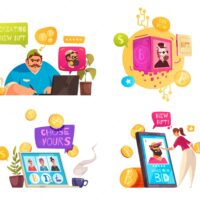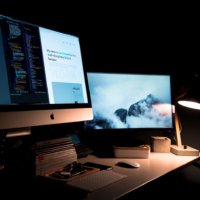A Step-by-Step Guide to Developing Your Own NFT
Developing your own Non-Fungible Token (NFT) can be a daunting task, but it doesn’t have to be. With a little research, some technical know-how, and plenty of patience, you can create a unique and valuable NFT that will make you stand out from the crowd. In this step-by-step guide, we’ll explain the basics of NFTs and how to develop your own. We’ll discuss the different types of NFTs, the tools you’ll need, and the steps to get started. By the end of this guide, you’ll have all the information you need to create your own NFT and begin your journey into the world of digital asset ownership.
What are the types of NFTs?
There are two main types of NFTs: fungible and non-fungible tokens. Fungible NFTs are tokens that are interchangeable and unique at the same time. For example, if you own one USD token, you own them all. You have one token that could be exchanged for any other USD token. One USD token is the same as the next USD token. Fiat money, for example, is a fungible token. One USD token is the same as another. Non-fungible NFTs, on the other hand, are tokens that are unique and not interchangeable. For example, if you own one Pokemon card, then you own one of a kind. You can’t exchange it for any other Pokemon card. One Pokemon card is the same as another one of a kind Pokemon card. Artwork is a non-fungible token. One artwork is the same as another artwork of the same type and source.
What are the tools needed for developing NFTs?
Before you start building your own NFT, you’ll need a few essential tools and resources. First, you’ll need to select the blockchain platform https://boostylabs.com/blockchain/nft for your NFT. There are many different blockchain platforms out there that support the creation of NFTs, including Ethereum, EOS, and NEO. You’ll also need to select the development language for your smart contract. While there are numerous programming languages you can use, we recommend using Solidity, a programming language designed specifically for Ethereum-based smart contracts. Once you’ve selected the blockchain platform and language, you’ll need to create a wallet to store your tokens. You’ll also want to install the right tools for creating your token and smart contract.
How to develop an NFT
Now that you know the different types of NFTs, the tools you’ll need, and the basic steps to develop an NFT, it’s time to put everything into practice. As with most things related to coding, developing an NFT can be tricky. Make sure you follow all the instructions carefully and double check everything before you move on to the next step. If you ever feel stuck or unsure about what you’re doing, look for help online. You can find plenty of resources and tutorials to help you out along the way. If you’re following along with a tutorial, make sure you understand the concepts behind it. You don’t want to rush through just to complete the tutorial. This can lead to errors and mistakes that are much harder to correct later on. Start by choosing your software and setting up your environment. Then create a token contract, deploy your token contract to the blockchain, and design your NFT. Once you’ve created your token, you can start trading.
How to find the right platform for your NFT
If you’ve developed an NFT, you’ll need to find a platform that can support it. While some blockchain platforms have their own built-in marketplace, others don’t. If you’re developing an NFT on a non-fungible blockchain platform, you’ll need to find a marketplace where your NFT can be listed and traded. If you’re developing an NFT on a fungible blockchain platform, you’ll need to find a marketplace where your NFT can be listed and traded. Once you’ve found a marketplace, you’ll need to decide whether you’ll list your NFT as a token or tokenized asset.
How to price your NFT
If you’re developing an NFT on a fungible blockchain platform, it’s advisable to tokenize your asset. Doing so allows you to set the initial value of your NFT. You can start by making a list of all the features and benefits your product or service has to offer. Next, add a suitable markup to account for startup costs, taxes, and other expenses you need to cover before your product or service becomes profitable. Once you know the value of your product or service, you can use it to determine the initial value of your NFT. If you’re developing an NFT on a non-fungible blockchain platform, it’s best to tokenize your product. Doing so allows you to set the initial value of your product. You can start by making a list of all the features and benefits your product or service has to offer. Next, add a suitable markup to account for startup costs, taxes, and other expenses you need to cover before your product or service becomes profitable. Once you know the value of your product, you can use it to determine the initial value of your NFT. Remember, though, your NFT isn’t a standard ERC20 token. Make sure you set the value of your NFT according to its real value.
How to market your NFT
After you’ve created your NFT, it’s time to start marketing it. Start by joining as many cryptocurrency forums and social media groups as possible. You can also create and host your own Telegram and Discord groups where you can engage with potential customers and users and answer any questions they may have. Make sure you have a clear and compelling message that conveys the value of your product or service. You can use compelling imagery and videos to engage potential customers and users and help them understand what your product or service is all about. Once your NFT is listed on a marketplace, you can start marketing it directly to potential buyers as well. You can use advertisements, emails, and newsletters to reach out to potential customers and encourage them to buy your product or service.
Conclusion
Creating a token on a blockchain platform is the easiest way to list and market a new product or service. In addition, by creating a non-fungible token, you’re creating a unique product that can’t be exchanged or replaced. This can make your product or service more desirable to customers who want something that is unique and special. Developing your own NFT is a challenging and time-consuming process, but it’s also an incredibly rewarding one. Once your NFT is listed on a marketplace, you can sit back and watch as it grows in value and becomes increasingly desirable to other users.





